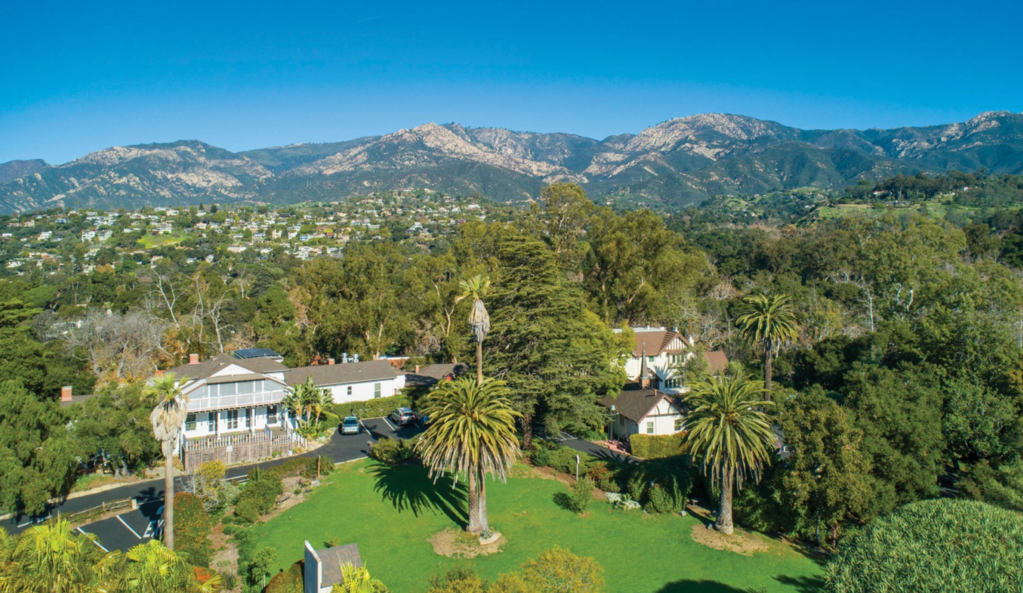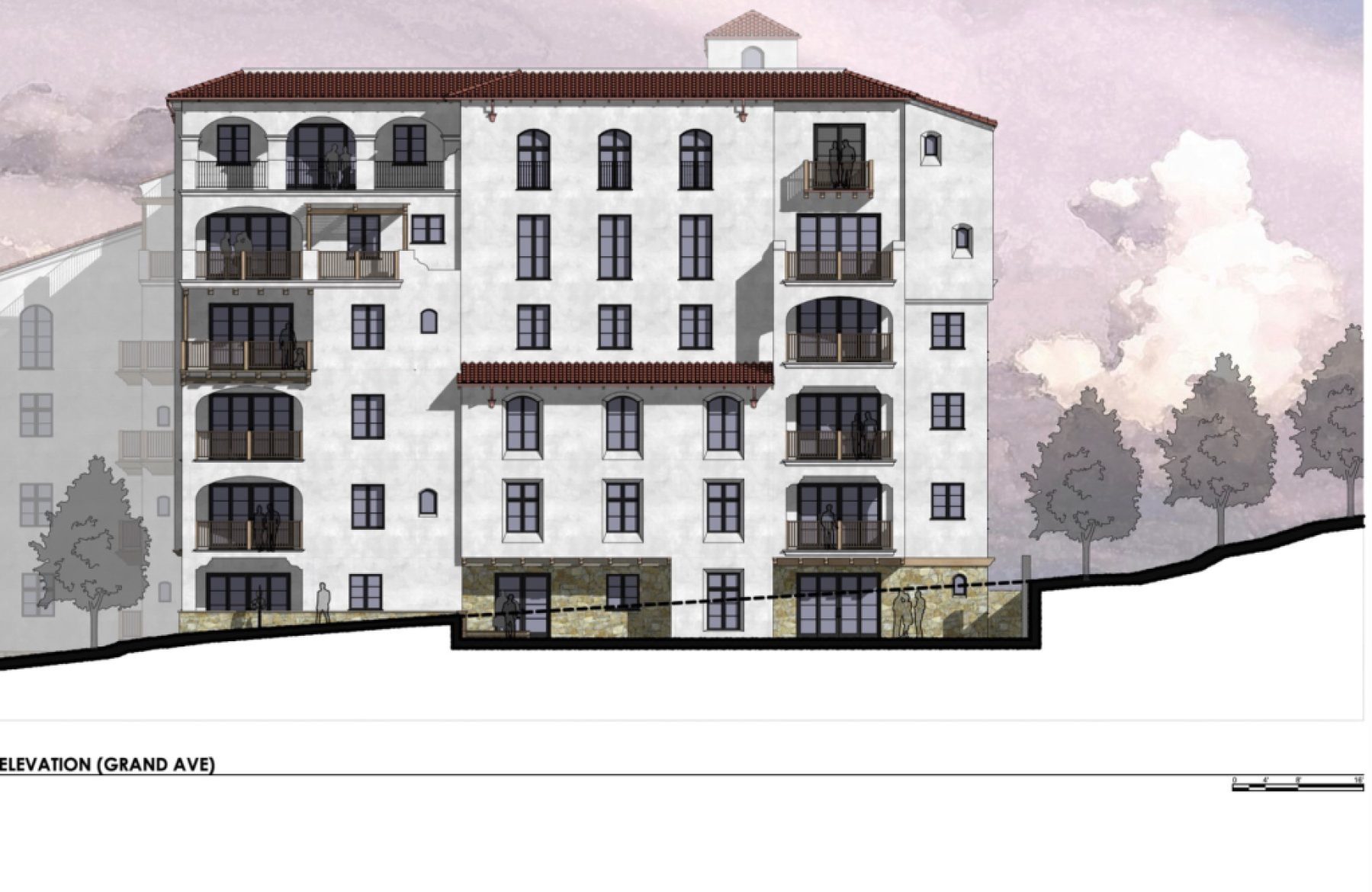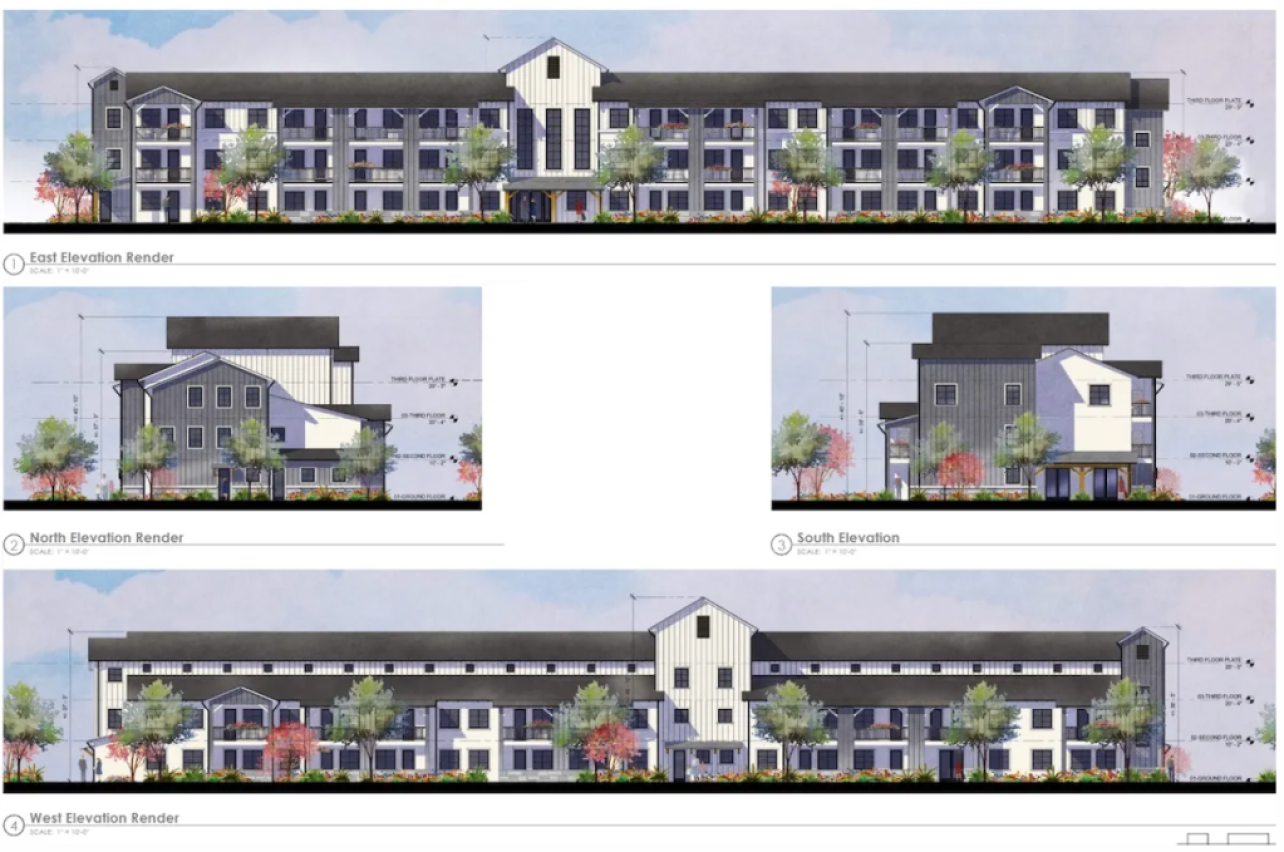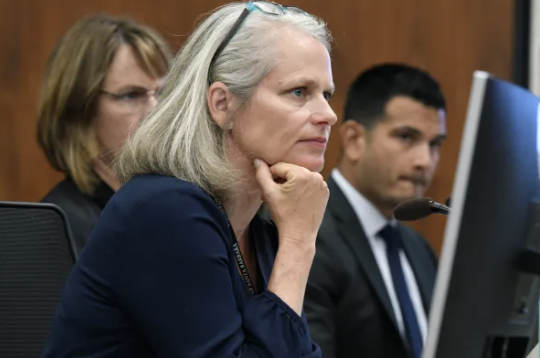
Nearly 5,000 Units of Housing
on the Fast Track
in Santa Barbara
How an Obscure Housing Law
Broke the Door Wide Open
for Developers Looking to Build
Bigger, Denser, and Quicker than Ever
By Ryan P. Cruz | January 17, 2024
A heavenly property sits hidden behind Old Mission Santa Barbara — a grand estate dating back more than a century and a religious retreat for decades. A developer is proposing to build 560 apartment units where two stately houses now stand on the property.
On an avocado orchard near Highway 217, a property that has been in agriculture for more than a century, the owners, a Goleta family, have proposed building 1,250 units on 64 acres.
Despite Santa Barbara’s notoriously nitpicky review boards, both developments have a very good chance of sailing through to completion, thanks to a little-known wrinkle in the housing law that has taken control out of the hands of local government and allowed developers an easy ride.
How Did We Get Here?
Santa Barbara has a severe housing shortage, an extremely limited number of affordable rentals, and a state government that is pushing for developers to build bigger, more densely packed housing quickly.
In February last year, both the city and county of Santa Barbara missed their deadlines to provide Sacramento with a plan for meeting the state’s projected housing requirements.
And although the city and county finally adopted their respective Housing Element plans in December, both remain technically out of compliance until the California Department of Housing and Community Development (HCD) gives final approval.
Enter the builder’s remedy, an obscure and previously overlooked piece of legislation that gives developers a fast pass through the review process. Fourteen such projects have been submitted in the county’s unincorporated areas and four in the city as of January 10. All told, that adds up to the possibility of nearly 5,000 units.

Sleeping Giant
What’s become known as the builder’s remedy is actually a legal interpretation of a couple of paragraphs buried deep in the Housing Accountability Act. Specifically, it was a portion added in 1990 that took away local agencies’ power to deny any housing development that offered at least 20 percent of its units as affordable if the region failed to have a compliant Housing Element.
For nearly 30 years, the builder’s remedy went unnoticed. Each eight-year cycle, Housing Element plans were updated, without fanfare. Cities and counties checked every box, and the state approved them. But as California’s housing crisis ramped up, the state started to apply more pressure on local jurisdictions, and in the most recent planning cycle, the long-dormant builder’s remedy came back into play.
“The builder’s remedy has been around,” said Frank Thompson, a housing consultant in Santa Barbara who has a knack for unraveling California’s enigmatic and ever-changing housing law. It really became a “thing,” he says, around 2021, when the pandemic forced an overwhelming majority of Southern California cities and counties to miss the state’s deadline for an updated Housing Element plan. At the time, the idea of submitting a housing development as a “builder’s remedy project” began floating around law-related blogs online.
Then it happened. In Santa Monica, attorney Dave Rand and developer Scott Walker submitted what was the first true builder’s remedy project: 14 residential buildings with 4,260 units packed along the beachside, including 18-story towers, all bigger, denser, and higher than anything ever permitted under that city’s zoning code.
“It’s really been driven by that law firm,” Thompson said. “One was a huge tower right by the bluffs. It was bound to make people mad.”
Eventually, the City of Santa Monica came to an agreement with the developer: The project was scaled down but granted a fast pass through the city review system, something that had never been done before.
New Rules
to the Game
Once the builder’s remedy was unlocked, the project applications came flying in across the state. Developments filing under State Bill 330, which put projects on the fast pass with no more than five review hearings, started popping up in Beverly Hills, Menlo Park, and La Cañada Flintridge, where the builder’s remedy got its first true test in court.
Until that point, much of what was known about the builder’s remedy was untested. “There’s a lot of things unknown,” Thompson said. “The couple paragraphs, in my view, are not super clear.”
The city of La Cañada Flintridge tried to deny an 80-unit project submitted under the builder’s remedy, claiming that it had “self-certified” its own Housing Element — a claim Governor Gavin Newsom and Attorney General Rob Bonta would shut down when the state took legal action against the city in December.
“Since California strengthened its housing laws, cities have attempted, unsuccessfully, to skirt these rules,” Newsom said on December 12. “La Cañada Flintridge is another community making excuses rather than building their fair share of housing. La Cañada Flintridge will learn, as other communities have, that the status quo is no longer acceptable, and ultimately, they will be held accountable.”
—Ryan P. Cruz
Open Season
Like most jurisdictions, the city and county of Santa Barbara were falling behind with their 2023-2031 Housing Element plans. By the time the state’s deadline of February 2023 came, officials were still deep in the weeds planning how to accommodate 5,664 units in the unincorporated areas of the county and 8,001 units in the city.

Then in May 2023, the first builder’s remedy project in Santa Barbara was filed by Los Angeles–based investment firm Industrial Partners Group, owned by a couple, Craig and Stephanie Smith, who had a deep and dramatic past. Craig, known as “Dr. 90210,” was famous for running a Beverly Hills liposuction clinic where he admitted to using his patients’ fat to create “LipoDiesel” fuel to power his family’s Mercedes GL320 Diesel. Stephanie, who worked at the same clinic, later made a name of her own as one of the biggest cannabis landlords in Los Angeles, eventually ending in a legal battle with the City of San Bernardino.
The Smiths announced their first Santa Barbara project — a 30-unit Spanish Colonial Revival across two lots on Grand Avenue — boasting in a press release, “Infilling these vacant lots is one step toward alleviating our community’s crisis-level housing needs. With the Builder’s Remedy, we are supporting California’s mandate to build affordable housing. Without Builder’s Remedy, this development would be limited to four units.”
The pre-application technically locked in the standards for the project for 180 days, which gave the developers until November 11 to submit a formal application. Instead, the Industrial Partners Group submitted a new application, this one even larger, stretching to six stories instead of five and now proposing 45 units across the same space.
“Fourteen such projects have been submitted in the county’s unincorporated areas and four in the city as of January 10. All told, that adds up to the possibility of nearly 5,000 units.”
A Big Dose
By the time the dust settled and the city and county adopted their housing plans, there was already a wave of projects that made the pre-application deadline. As of press time, the state has yet to approve their Housing Element drafts, and both the city and county are among the 225 local agencies still out of compliance for this cycle.
In addition to the 45-unit project on Grand Avenue, there were three more projects in the City of Santa Barbara, combining for a total of 632 units, 126 of which would be affordable to low-income households.
One project is a 27-unit development proposed for a vacant lot on Hot Springs Road across from the Santa Barbara Cemetery. The projects at 505 East Los Olivos Street, tucked behind the Old Mission Santa Barbara, are on a 4.8-acre property that originally belonged to the Hazard family, who built one of the two homes, as well as the Mission Creek stone bridge, in 1885. The estate has been used as a retreat and Episcopal monastery for the past hundred years. The two homes are both slated to be demolished and replaced with two large apartment buildings — one with 320 units, and another with 240.
The county saw 14 applications, spanning from the outskirts of wine country to the edge of Goleta and Carpinteria. Altogether, the 4,360 units would have 878 apartments designated as affordable housing.
Four other properties are in the Eastern Goleta Valley. The largest is a 1,253-unit development proposed across 64 acres of avocado orchards and agricultural fields off Hollister Avenue owned by the Giorgi family. The Oak Creek Company CEO Jeff Nelson, who is behind the development plans, said that the property “is an opportunity to stick together and connect much-needed housing with adjacent and nearby uses.”
Not far away from the Giorgi property are three more builder’s remedy projects all neighboring each other near Hollister and San Marcos Road — 1,672 units altogether. At San Marcos Growers — owned by the Brett Hodges Revocable Trust and submitted by Andrew Fuller of San Marcos Ranch, LLC — there are 996 units proposed across 27 acres.
Directly adjacent to the San Marcos Growers are the Montessori development — 345 units across 11 acres owned by Montessori Center School at Santa Barbara — and the Tatum development, which is 331 units proposed across 23 acres.
The Tatum property is owned by the Santa Barbara Unified School District and submitted by Red Tail Multifamily Land Development, which submitted another builder’s remedy project on the outskirts of Carpinteria on Bailard Avenue. The 173-unit Bailard Avenue project was previously owned by Carpinteria Unified School District and will be a collaboration between Red Tail and the Housing Authority of the County of Santa Barbara, which will be in charge of the 41-unit affordable housing portion of the development.

Familiar Faces
The 18 different projects in the city and the county are owned and developed by a mix of shell companies and familiar faces who have been trying to develop high-profile properties for years. In Isla Vista, there are six projects filed under the builder’s remedy.

At 6757 Del Playa, on a third of an acre near the cliffside, a four-unit development is proposed by the vaguely named SBJV1 Property Owner, LLC, which is registered to Beverly Hills investor David Nazarian of Nimes Real Estate. Nazarian is also the registered contact for another builder’s remedy development a few blocks away on Cervantes Road, which currently has 22 units but is proposing a total of 49 units under the builder’s remedy.
The most ambitious project in Isla Vista may be at a .12-acre lot on Madrid Road, where a Fullerton-based company will attempt to squeeze 45 units on a sliver of space that was once the home to a car wash before its most recent incarnation as a used bike shop.
The last three builder’s remedy projects in Isla Vista — two properties on Camino del Sur and another on Sabado Tarde — are owned by LLCs that can be traced to Chris and Julie Proctor, a pair of longtime UCSB donors who have deep ties to the college community.
In the North County, there are three projects for a total of 1,108 units. Just west of Lompoc is a 322-unit development across 49 acres, which has been at the center of a land-use battle between the city, the county, and owner Jack Bodger. Bodger, who runs his family seed company John Bodger and Sons Co., has been trying to develop his land for years, and after being kept from Lompoc’s sphere of influence and then denied by Santa Barbara County’s Local Agency Formation Commission (LAFCO), he is now taking his chances with the builder’s remedy.
In Orcutt, for a plot of land dubbed “Key Site 26,” there is a proposal for 750 units of urban infill housing on 43 acres of open space formerly owned by the Richards family. The applicant, Richards Ranch LLC, is led by Michael Stoltey of MD3 investments in San Luis Obispo. The family sold the land to Walmart in 2006, but since Stotley acquired the property he has been attempting to have the parcels annexed into the city of Santa Maria, originally as a 400-unit mixed-use development, before applying with a much more dense project through the builder’s remedy.
And at Rancho La Laguna, a plot of land deep in the hills of wine country on Foxen Canyon Road, a Hollywood husband and wife are hoping to build 13 farmworker units, 13 single-family dwellings, and 10 multi-family units. The project was submitted by Rancho La Laguna LLC, the company of actress Stephanie Haymes-Roven, of Wonder Woman and Justice League, and her husband, Charles Roven, a producer on movies such as The Dark Knight and American Hustle.
Will There Be Water?

The South Coast’s water agencies have made plans against the inevitable recurrence of drought with new housing construction in mind, including this 173-unit builder’s remedy project at Bailard Avenue on land owned by the Carpinteria Union School District. | Credit: RRM Design Group
Of the 14,881 units proposed to be built in South County under the state housing mandate, more than 3,000 are under builder’s remedy in the territory covered by the Goleta Water District, and about 173 in the Carpinteria Valley Water District. All water agencies are keeping an eye on the possibility of rain and the inevitability of drought, with Goleta just coming out of a moratorium and Carpinteria actively pursuing toilet-to-tap resources.
Lake Cachuma, the South Coast’s largest water reservoir, is 90 percent full. Today, one-third of the way into the current rain year, area water agencies seem sanguine that the supply will last through to the 2025 water year.
Goleta Water District serves the geographic area from El Capitan to the City of Santa Barbara border, and it carries the bulk of the new housing/zoning proposals for the South Coast. Last year’s wet winter allowed the district to end a nearly decade-long water-meter moratorium, releasing about 154 acre-feet annually, which is enough for possibly 1,000 apartments. The Giorgi builder’s remedy development, on county lands just outside the Goleta city border, could raise 1,253 units on 64 acres of ag land.
Carpinteria Valley Water District is the smallest among the South Coast water agencies, though it serves 11,300 acres of homes and agricultural lands. About 1,100 units may grow in the area in the next eight years, both in the City of Carpinteria and in county lands, one of them the builder’s remedy proposal of 173 units on school district property at Bailard Avenue.
“In a normal year, we have plenty of water to support that demand,” said General Manager Bob McDonald of the 230 acre-feet of additional water a complete buildout would require. Faced with the likelihood of drought, the district has worked on an Advanced Purification Project with the Carpinteria Sanitary District since 2016 and expects to have funding in place this year. The end result will be treated to potable water standards and injected into the groundwater basin for storage, McDonald said, before being removed after several years and added to the treatment system.
The South Coast’s largest water user is the City of Santa Barbara, which has its own water agency, and projections of housing, population, the economy, and water use out to 2050 indicate that the city’s desal plant meets the current demand and could be expanded if “reduced supplies drive the need for new water supplies,” said Dakota Corey, who is responsible for long-range water planning.
Montecito Water District signed a 50-year agreement with the City of Santa Barbara to fund 46 percent of the desal plant’s costs, or $33 million. It receives 1,430 acre-feet of water, or 40 percent of the water used for Montecito’s businesses, homes, and gardens. Montecito has perhaps 60 new units proposed toward the county’s Housing Element and none at the moment under builder’s remedy.
—Jean Yamamura
Sure Thing or Long Shot?

This is all-new terrain for the planning teams in Santa Barbara. In the county, it was a grueling couple of months for Director of Planning & Development Lisa Plowman and Supervising Planner Allen Bell, who, along with the rest of the planning division, juggled the pressure of the state with the priorities of the public and the Board of Supervisors. Unlike the City of Santa Barbara, the county was in the difficult position of having to find sites to rezone for housing as part of its housing plan. After heavy debate, the county decided to adopt its Housing Element and choose which sites to rezone separately.
But with the county behind deadline, and still without a compliant Housing Element, it had the biggest portion of builder’s remedy projects in the area. Goleta and Carpinteria both escaped without any applications on city land, and the City of Santa Barbara managed with only a few.
Out of these 14 county applications, 12 of them are considered to be in the “pre-application phase.” The County Planning Division explained that the pre-application status meant that the applicants had locked in their standards at the time of submission, and they now had 180 days to submit a formal application. At this point only two properties — Tatum and Bailard, both run by Red Tail — have submitted their formal applications.
“If they fail to submit the formal application within that time frame,” Bell said, “their preliminary application is nullified, and they are no longer vested.”
“Despite Santa Barbara’s notoriously nitpicky review boards, both developments have a very good chance of sailing through to completion, thanks to a little-known wrinkle in the housing law that has taken control out of the hands of local government and allowed developers an easy ride.“
If a plan is missing any information, the applicant then has 90 days to provide the information needed in order to remain valid. If the state finds the city and the county in “substantial compliance” before the 180 days, the applicants still reserve the right to their complete window of time, but no new builder’s remedy applications will be accepted once the state gives the local plans full approval. Both the city and the county are expecting to be in full compliance by the end of March.
Some of the projects will likely not make it to the level of submitting a full application. In order to do that, the developer must check all the objective boxes, and their project must be ready to go after no more than five public hearings. What may happen, as in other jurisdictions across the state, is that the developers use their builder’s remedy project as leverage to get approved for a project that would have gone through intense scrutiny under other circumstances. Only time will tell, but whatever the outcome, the game may be forever changed.




You must be logged in to post a comment.